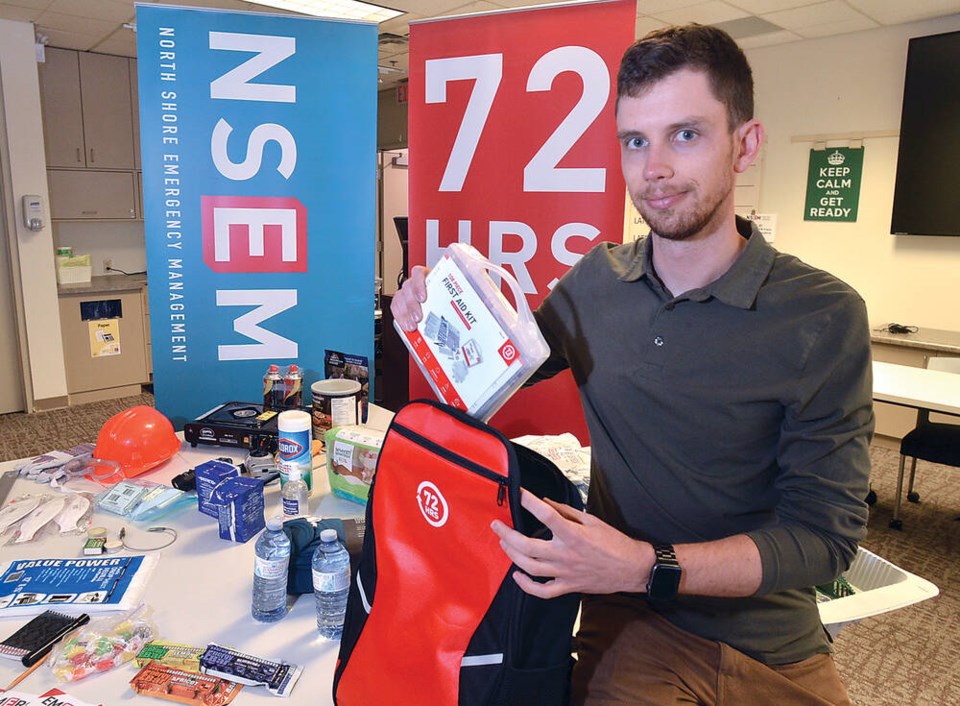Know the risks. Build the kit. Make a plan.
It’s the mantra North Shore Emergency Management drills home to anyone who will listen about preparedness for disasters like earthquakes, wildfires or floods, all of which could strike in Metro Vancouver.
But a majority of local residents haven’t done the basics, according to a North Shore News poll, which found more than 60 per cent of North Vancouver and West Vancouver residents admitting they don’t have an emergency kit or a plan.
“It’s not that people don’t want to be prepared, it’s just that they don’t understand the magnitude of the disruption,” said Emily Dicken, NSEM director. “It’s everybody’s responsibility to be prepared for natural disasters or hazards in the community.”
The emergency kit
To start with, NSEM recommends every household have a kit with supplies to support everyone living there for at least 72 hours of sheltering in place at home (though one week’s worth would be better).
The basics include: Non-perishable foods such as canned goods or energy bars, a manual can opener, four litres of water per person per day, a first aid kit, a flashlight and radio that are either powered by a hand crank or by batteries (with plenty of backup batteries), cash in small bills, copies of everyone’s ID like drivers’ licences, passports, insurance papers and birth certificates, and extra prescription medication and baby formula, if needed. If you have pets, make sure there’s a supply of food and water for them too.
NSEM also highly recommends people have a backup power supply that could be used to recharge smartphones.
But most of what’s in your home emergency kit won’t be of use to you if you’re forced to evacuate on short notice. For that, you should have a grab-and-go bag containing 24 hours’ worth of supplies listed above and some “comforts of home” that will help buttress your family’s mental health during a highly stressful time.
The emergency plan
Having a cache of supplies is only part of what will help get you through the aftermath of a disaster, Dicken said. Sitting at the top of your emergency kit should be a printed copy of your household’s emergency plan that lays out contingencies for communication, reuniting family members and mitigating the risk of “compound emergencies” – things like fires and flooding that could follow a disaster.
First off is researching what hazards your home and your neighbourhood are most likely to face, Dicken said, allowing you and your neighbours to plan accordingly.
“There might be folks that live next door to you that have different resources or capabilities that could help you if you’re more vulnerable in specific areas,” she said.
The utilities that keep our homes running may themselves become a threat or something to exacerbate the situation, so Dicken said everyone should know where the natural gas, water or electrical connections are and what the points of shut-off are. Most utility providers already have clear instructions on what to do if you need to shut off service to your home in an emergency.
The plan should include a list of phone numbers, emails, the critical health needs of the people that live in the house, as well as the people they’re going to need to connect with post-disaster, Dicken said.
Communication may be more difficult locally following a disaster, so Dicken recommends each plan include an out-of-area contact who could be a central “checking in” point.
Every household plan should have an agreed upon location where family members can meet up if they are unable to get back into their homes, possibly outside their own neighbourhood, which may not be accessible.
Following a disaster, it will be more important than ever to rely on trusted sources of information. For those on the North Shore, NSEM’s Alertable smartphone app will provide real-time updates and instructions tailored right down to affected neighbourhoods. Dicken also recommends the @EmergencyInfoBC Twitter account.
Help is on the way
It’s daunting to think about disasters, Dicken acknowledged, but she said experience has shown that people who have done proper planning and preparedness cope far better when the worst happens.
The above advice should be viewed as a jumping-off point, rather than an exhaustive list. To fill in the gaps, NSEM is as much about public education as they are about disaster response.
“Our doors are open during business hours,” she said. “We’re really happy to provide people with the resources to get them started on their journey.”




